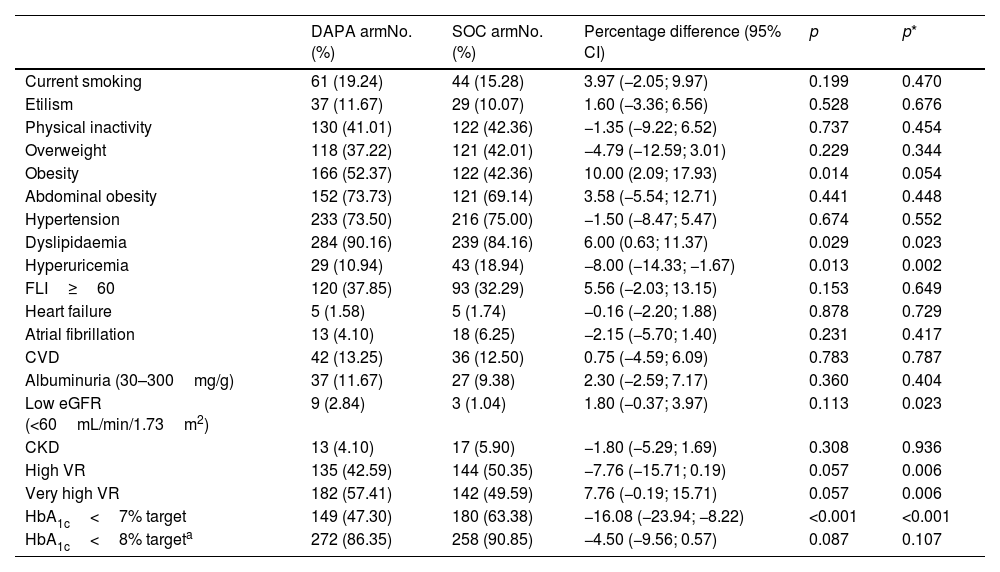Type 2 diabetes mellitus (T2D) has acquired epidemic proportions worldwide. In recent years, new oral glucose-lowering drugs (OGLD) have emerged that improve the cardiovascular–kidney–metabolic control in T2D people.
ObjectivesTo compare the baseline clinical–biological characteristics among T2D people to whom had added-on dapagliflozin (DAPA group) or another OGLD (SOC group) second-line hypoglycaemic therapies among the AGORA study population.
MethodsThis is a multicentre cross-sectional observational study of the baseline characteristics of T2D people recruited through competitive sampling among 46 primary care health centres in Spain for the AGORA study. The inclusion and exclusion criteria of participants, and justification of the sample size are reported. After verifying the data necessary to be evaluated and informed consent, 317 subjects were included to the DAPA group and 288 to the SOC group. Both categorical and continuous variables were analysed and compared with the usual statistics. Cohen's d was used to assess the standardised difference in means.
ResultsSix hundred and five patients with T2D were assessed (mean age 63.5 [SD±8.1] years, 61.8% men), whom 17.4% were smokers, 47.6% had obesity, 74.8% hypertension, 87.3% dyslipidaemia, and 41.7% reported physical inactivity, with no significant differences between both comparison groups. The mean (SD) evolution time of T2D was 10.1 (5.6) years. Most baseline clinical–biological characteristics at recruitment were similar in both groups. However, DAPA group was younger (2.9 years), and had lower systolic blood pressure (SBP) (2.8mmHg), higher body weight (BW) (3.7kg), and higher glycated haemoglobin A1c (HbA1c) (0.3%) than SOC group. Only 11.5% of participants had poor glycaemic control (HbA1c>8%) at recruitment, 54.9% had good glycaemic control (HbA1c<7%), being significantly lower in the DAPA group (47.3%) than in the SOC group (63.4%). The percentage of T2D patients with high vascular risk (VR) was 46.3%, and 53.7% with very high VR, being significantly higher in the DAPA group (57.4%) than in the SOC group (49.6%).
ConclusionsMost baseline cardiovascular–kidney–metabolic characteristics were similar in T2D patients whom had added dapagliflozin on second-line hypoglycaemic therapy as those whom had added-on another OGLD. However, patients whom had added-on dapagliflozin had higher VR, lower SBP, higher BW, and slightly worse HbA1c control. Future research is necessary to explain the causes of these differences in cardiometabolic control.
La diabetes mellitus tipo 2 (DM2) ha adquirido proporciones epidémicas en todo el mundo. En los últimos años han surgido nuevos fármacos hipoglucemiantes orales (OGLD) que mejoran el control cardiovascular-renal-metabólico en personas con DM2.
ObjetivosComparar las características clínico-biológicas basales entre personas con DM2 a las que se les había añadido dapagliflozina (grupo DAPA) u otro OGLD (grupo SOC) como terapias hipoglucemiantes de segunda línea, en la población del estudio AGORA.
MétodosEstudio multicéntrico observacional transversal sobre las características basales de personas con DM2 reclutadas mediante muestreo competitivo en 46 centros de atención primaria en España para el estudio AGORA. Se describen los criterios de inclusión y exclusión de los participantes, y la justificación del tamaño de la muestra. Tras comprobar los datos necesarios para ser evaluados y el consentimiento informado, 317 sujetos se incluyeron en el grupo DAPA y 288 en el grupo SOC. Las variables categóricas y cuantitativas se analizaron y compararon con los estadísticos habituales. Se utilizó la d de Cohen para evaluar la diferencia estandarizada de medias.
ResultadosSe evaluaron 605 pacientes con DM2 (edad media 63,5 [DE±8,1] años, 61,8% hombres), de los cuales 17,4% eran fumadores, 47,6% tenían obesidad, 74,8% hipertensión, 87,3% dislipidemia y 41,7% referían inactividad física, sin diferencias significativas entre ambos grupos de comparación. El tiempo medio (DE) de evolución de la DM2 era de 10,1 (5,6) años. La mayoría de las características clínico-biológicas basales al reclutamiento fueron similares en ambos grupos. Sin embargo, el grupo DAPA era más joven (2,9 años) y tenía una presión arterial sistólica (PAS) más baja (2,8mmHg), un mayor peso corporal (3,7kg) y una hemoglobina glicada A1c (HbA1c) más alta (0,3%) que el grupo SOC. Sólo el 11,5% de los participantes tenía un control glucémico deficiente (HbA1c>8%), el 54,9% tenía un buen control glucémico (HbA1c<7%), siendo significativamente menor en el grupo DAPA (47,3%) que en el grupo SOC (63,4%). El porcentaje de pacientes con DM2 con riesgo vascular (RV) alto era del 46,3%, y del 53,7% con RV muy alto, siendo significativamente mayor en el grupo DAPA (57,4%) que en el grupo SOC (49,6%).
ConclusionesLa mayoría de las características cardiovascular-renal-metabólicas basales eran similares en los pacientes con DM2 a los que se les había añadido dapagliflozina en terapia hipoglucemiante de segunda línea como a los que se les había añadido otro OGLD. Sin embargo, los pacientes a los que se les había añadido dapagliflozina tenían un RV más alto, una PAS más baja, un mayor peso corporal y un control de HbA1c ligeramente peor. Son necesarias más investigaciones para explicar las causas de estas diferencias del control cardiometabólico.
Artículo
Comprando el artículo el PDF del mismo podrá ser descargado
Precio 19,34 €
Comprar ahora








